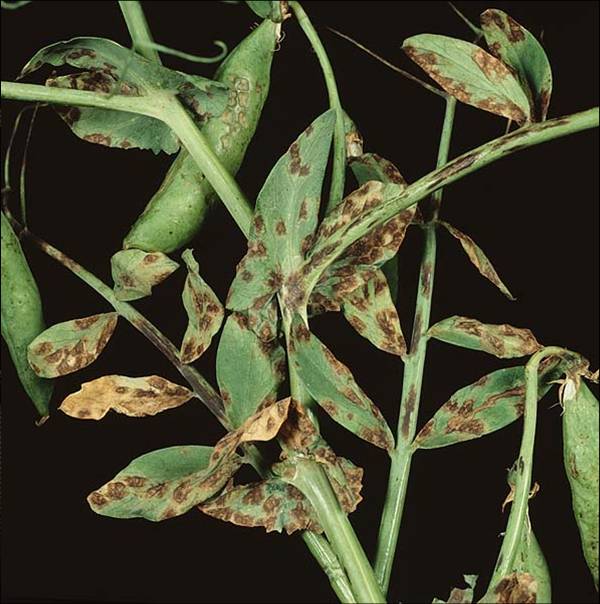
The protectant and systemic fungicide Signum has gained approval for use in vining peas and combining peas, a welcome addition to the limited options that pulse growers have to control disease in their crops. Based on pyraclostrobin and boscalid, Signum is already fully approved for use in a range of brassicas, carrots and beans.
Dr. Anthony Biddle, Technical Director of PGRO, points out that with the possible cold start to drilling plus one-third of vining peas being grown in Scotland, disease risk in peas could be higher this year. "Later drilled crops tend to be at higher risk as they reach the right growth stage when the weather is right for disease development. Disease risk is higher when it is wetter. It is important that combining and vining pea growers should assess their disease risk and consider their options, including the newly approved Signum, ahead of the game."
He explains that in combining peas the main diseases to look out for are Leaf and Pod spot (Mycosphearella pinodes and Ascochyta pisi.) "Combining peas, particularly marrow fats, also commonly suffer from powdery mildew, when the weather is warm and dry. With one-third of peas being marrow fats, powdery mildew could be a more significant potential problem. In combining peas a programme of two fungicide sprays may be worthwhile, starting at T1 at flowering to first pod set and followed by a T2 spray 14 days later. Signum will have a useful place in the programme, integrating it with other fungicides such Walabi (pyrimethanil and chlorothalonil) and Sunorg Pro (metconazole)."
In vining peas you normally get one shot at disease control from flowering to first pods set. Here you are usually targeting Botrytis, Leaf and Pod spot and rarely Sclerotinia. Once again Signum would be a promising product to consider this year, says Anthony Biddle.
"Signum is already a well known and widely used product in pulses, where it controls chocolate spot (Botrytis cinerea and B. fabae) and rust (Uromyces fabae) in spring and winter beans. If wet weather builds and disease development flares up, disease will develop in peas very fast and spraying action will be needed. Disease can affect yield by as much as 30%, according to the PGRO as well as the quality of peas, particularly when damp and humid at flowering," says Jonathan Ball, Pulse Marketing specialist for BASF.
"Signum will have an important role to play and has an excellent technical reputation for effective and consistent disease protection, reflected in trials. For example in trials Signum gave excellent control of Leaf and Pod spot, reducing the level of disease on the bottom of the plant from 91.2% down to 54.6%, better than an azoxystrobin and chlorothalonil mix. More importantly 0.5 kg/ha of Signum applied between flowering and first pods visible resulted in 16% extra yield over the untreated, which was 5% more than azoxystrobin and chlorothalonil. Signum also gave better control of powdery mildew than the standards," says Jonathan.
"We hope that this new approval in peas will be a useful addition to the dwindling portfolio of fungicides available to pea growers and will play its part in the continuing production of high quality peas."
Notes : Signum contains 67 g/kg pyraclostrobin and 267 g/kg boscalid and is formulated as a water dispersible granule (WDG). It will control Leaf and Pod spot in vining and combining peas. It is recommended at a dose rate of 1 kg/ha. In vining peas one application can be made with a harvest interval of 14 days. In combining peas two applications up to a total dose of 2kgs/ha can be made with a harvest interval of 21 days. In addition to peas, Signum is also approved for use in winter field beans, spring field beans, broccoli, Brussels sprouts, cabbage, cauliflower and carrots.
Walabi contains 150 g/l pyrimethanil and 375 g/l chlorothalonil formulated as a suspension concentrate. It is approved as a protectant treatment against Botrytis cinerea, Ascochyta pisi, and Mycosphaerella pinodes in all varieties of combining peas. It is recommended at dose rates of between 1.5 to 2 l/ha and up to two applications can be made. Walabi has a harvest interval of 6 weeks in peas.
Sunorg Pro contains 90 g/l metconazole, formulated as a soluble concentrate and packed in a 5-litre pack. It is a broad-spectrum fungicide with curative and protectant activity. It reduces Mycosphaerella pinodes, Ascochyta pisi, and Botrytis in combining peas, vining peas and lupins as well as controlling rust in these crops and field beans at a dose rate of 0.8 l/ha. Up to two applications can be made, with a harvest interval of 14 days.
